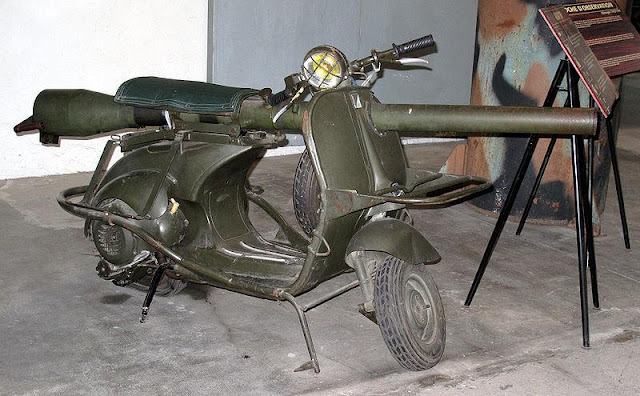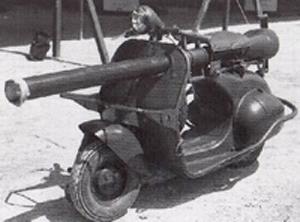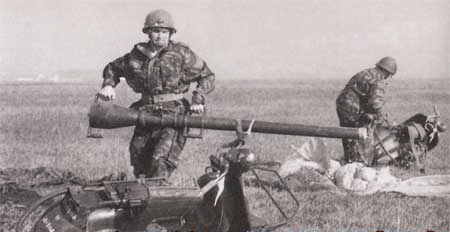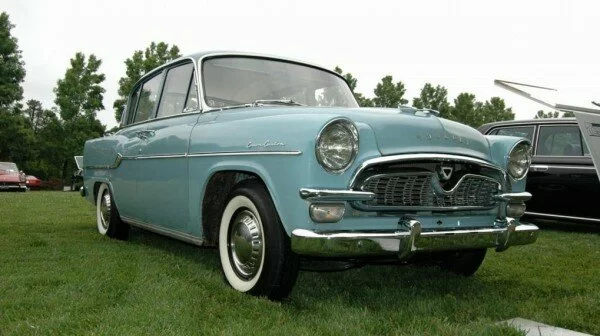September 19, 2010 – 1:41 am
 |
| Vespa 150 TAP 1956-1959 |
Vespa 150 TAP Specifications :
Manufacturer : Piaggio (France)
Productions : 1950′s
Photo Credit : Rama and symboles-et-traditions.com
The Vespa 150 TAP is an Italian Vespa scooter modified to transport a M20 75 mm recoilless rifle, which was used in the 1950s by the French Airborne Forces (Troupes aéroportées, or TAP). It was produced by Ateliers de Construction de Motocycles et Automobiles (ACMA), a licensed assembler of Vespas in France, in 1956 and 1959.
Its mounted M20, a U.S.-made light anti-armour cannon, was very light when compared to a standard 75mm cannon but was still able to penetrate 100 mm of armour by so-called HEAT warhead. The recoil is counteracted by venting propellant gases out the rear of the weapon which eliminated the need for a mechanical recoil system or heavy mounts, enabling the weapon to be fired from the Vespa frame.
 |
| Vespa 150 TAP 1956-1959 |
 |
| Vespa 150 TAP 1956-1959 |
The scooters would be parachute-dropped in pairs, accompanied by a two-man team. The gun was carried on one scooter, while the ammunition was loaded on the other. Due to the lack of any kind of aiming devices the recoilless rifle was never designed to be fired from the scooter, the gun was mounted on a tripod which was also carried by the scooter, before being fired.
The “Bazooka Vespa” was relatively cheap: Vespas cost roughly $500 at the time, and the M20s were plentiful. Roughly 800 of these scooters were deployed in the Algerian War.
 |
| Vespa 150 TAP 1956-1959 |
Source : wikipedia.org
 Manufacturer : Bentley
Manufacturer : Bentley
 Productions : 1956-1959
Productions : 1956-1959
 Engine : 4.9 L (4887 cc/298 in³) straight-6
Engine : 4.9 L (4887 cc/298 in³) straight-6
 Transmission : 4-speed automatic transmission was standard, with a 4-speed manual available as an option
Transmission : 4-speed automatic transmission was standard, with a 4-speed manual available as an option
 Source : netcarshow.com
Source : netcarshow.com
The Bentley S1 was a luxury car produced by Bentley Motors Limited from 1956 through 1959. It marked Bentley parent, Rolls-Royce, reducing the differences between their Bentley and Roll-Royce models, with the S1 differing only in its radiator design and badging from the Rolls-Royce Silver Cloud I.
The models shared the 4.9 L (4887 cc/298 in³) straight-6 engine, with this being the last vehicle to use this engine. The bore was 95.25 mm (3.7 in) and the stroke was 114.3 mm (4.5 in). Twin SU carburetors were fitted, with upgraded models from 1957. A 4-speed automatic transmission was standard, with a 4-speed manual available as an option. Two wheelbases were produced: 123 in (3124 mm) and, from 1957, 127 in (3226 mm).
Tags 1956-1959, Bentley, S1 Continental |

1959 Toyota Toyopet Crown specifications :
Manufacturer : Toyota
Productions : 1959
Engine : 4 cylinders, 1543cc, 60 HP, gasoline-petrol fuel type, manual 3 speeds, rear wheel drive. read more »
 Manufacturer : Aston Martin
Manufacturer : Aston Martin
 Productions : 1959-1963
Productions : 1959-1963
 Engine : dohc I-6, 3670 cc; 302 bhp (Aston Martin DB4 GT) 314bhp (Aston Martin DB4 GT Zagato) @ 6000 rpm, 240 lbs-ft @ 5000 rpm
Engine : dohc I-6, 3670 cc; 302 bhp (Aston Martin DB4 GT) 314bhp (Aston Martin DB4 GT Zagato) @ 6000 rpm, 240 lbs-ft @ 5000 rpm
 Transmission : 4-speed manual DB
Transmission : 4-speed manual DB
 Source : netcarshow.com
Source : netcarshow.com
The Aston Martin DB4 GT Zagato made its premiere at the 1959 London Motor Show. The car was designed by Aston Martin and used the Superleggera body frame system – aluminium panels on tubular support frames – produced by Carrozzeria Touring of Milan. Although similar to the Aston Martin DB4, the differences added up to a very different motor car.
Technical Specifications
Engine: dohc I-6, 3670 cc; 302 bhp (Aston Martin DB4 GT) 314bhp (Aston Martin DB4 GT Zagato) @ 6000 rpm, 240 lbs-ft @ 5000 rpm
Transmission: 4-speed manual DB
Suspension: Front: upper-and-lower A-arms, coil springs, anti-roll bar Rear: live axle, Watt linkage, trailing links, coil springs
Brakes: front/rear discs
Length: 14’4″
Width: 5’6″
Height: 4’4″
Wheelbase: 7’9″
Weight: 1269 kg (2798 Ibs)
Top Speed: 153 mph
0-60 mph: 6.4 sec.
Price New: £ 4534
Production: 75
read more »
 Manufacturer : Cadillac
Manufacturer : Cadillac
 Productions : 1953-1959
Productions : 1953-1959
 Engine : 5422 cc, 8-V, OHV, 2 valves per cylinder
Engine : 5422 cc, 8-V, OHV, 2 valves per cylinder
 Source : netcarshow.com
Source : netcarshow.com
The Cadillac Eldorado was the longest running American personal luxury car as it was the only one sold after the 1998 model year. Its main competitors included the Mark Series and the lower-priced Buick Riviera. The name Eldorado was derived from the Spanish words “el dorado”, the “gilded one”; the name was given originally to the legendary chief or “cacique” of a S. American Indian tribe. Legend has it that his followers would sprinkle his body with gold dust on ceremonial occasions and he would wash it off again by diving into a lake. The name more frequently refers to a legendary city of fabulous riches, somewhere in S. America, that inspired many European expeditions, including one to the Orinoco by England’s Sir Walter Ralei
read more »
 Manufacturer : Columbia
Manufacturer : Columbia
 Productions : 1959
Productions : 1959
 Source : Nostalgic.net
Source : Nostalgic.net
Rare Columbia Fire-Arrow 2-speed middleweight. Candy red and white two-tone with chrome. Overal fair condition. A scarce bike, hard to find in good shape. This bike needs only minor work to be a good rider. Rear hub should be rebuilt. Goodyear whitewalls are in excellent condition.
read more »
Tags 1959, Columbia, Fire Arrow |
Lancia Appia (1959)
 Manufacturer : Lancia
Manufacturer : Lancia
 Productions : 1959)
Productions : 1959)
 Source : netcarshow.com
Source : netcarshow.com
1959 Aston Martin DBR4
 Manufacturer : Aston Martin
Manufacturer : Aston Martin
 Productions : October 1958 – June 1963
Productions : October 1958 – June 1963
 Engine : all dohc I-6, 3670 cc, 240 bhp @ 5500 rpm, 240 lbs-ft @4250 rpm; Vantage: 266 bhp @5750 rpm
Engine : all dohc I-6, 3670 cc, 240 bhp @ 5500 rpm, 240 lbs-ft @4250 rpm; Vantage: 266 bhp @5750 rpm
 Transmission : 4-speed manual with optional overdrive or optional Borg-Warner 3-speed automatic
Transmission : 4-speed manual with optional overdrive or optional Borg-Warner 3-speed automatic
 Source : netcarshow.com
Source : netcarshow.com
Work on the DB4 started in 1956, at the same time as the DB Mark III. The key people involved in the development of the DB4 were general manager John Wyer, chassis designer Harold Beach, and engine designer Tadek Marek. Every major component in the DB4 was new. The four-seater body was design by Carrozzeria Touring of Milan, using their ‘Superleggera’ system by which alloy panels are fixed to a tubular frame built onto the very strong platform chassis.
The entirely new car was shown at the London Motor show in 1958, sharing a stand with the DB Mark III which was to continue in production for almost a year. The DB4 was the first production car to capable of 0-100-0 mph in under 30 sec. claiming to reach the 100 mph mark in 21 seconds. A very impressive car that put Aston Martin back in competition with other Mediterranean sports car manufacturers.
A four-seater convertible was announced at the London Motor Show in 1961.
 Manufacturer : Volkswagen
Manufacturer : Volkswagen
 Productions : 1977-1979
Productions : 1977-1979
 Engine : 50 PS (37 kW) 1043 cc
Engine : 50 PS (37 kW) 1043 cc
 Source : netcarshow.com
Source : netcarshow.com
The Mk I Polo, a rebadged version of the Audi 50, was introduced in 1975. The differences between the Audi and VW models were minor, with the Polo being cheaper and much more basic. The two cars were initially sold along side each other, but the Audi 50 never sold as well, and was withdrawn in 1978. The Polo was manufactured at the Volkswagen plant in Wolfsburg. In 1977, the Derby sedan was released, which was simply a Polo, identical to the hatchback from the C-pillar forward, with a large boot attached (an old Audi proposal, but never sold by this brand).
When first on sale the range topping car, the LS model, featured the 50 PS (37 kW) 1043 cc engine found in the Audi 50. Other specifications included parking lights, rear wash wipe, sun visors, chromed bumpers and 4.5J X 13″ wheels. The N model was the basic starting spec lacking many of the features of the LS. In 1979 the GLS was introduced, replacing the LS as the range-topping car; specification upgrades included chrome headlight and grill surrounds, sunroof, a cigarette lighter and chrome wheel trims.
895 cc, 1093 cc and 1272 cc engines were used, with the smaller one used only in the Polo hatchback, and the 1272 cc only in the Derby, Audi 50, and the rare Polo GT. Different levels of compression were used on each size to achieve different power outputs, and the variations are numerous, often differing depending on the country of sale, ranging from 35 to 60 PS (26 to 44 kW).
 Manufacturer : Saab
Manufacturer : Saab
 Productions : 1960
Productions : 1960
 Engine : 841 cc three-cylinder two-stroke engine
Engine : 841 cc three-cylinder two-stroke engine
 Transmission : Four-speed manual transmission
Transmission : Four-speed manual transmission
 Source : netcarshow.com
Source : netcarshow.com
The Saab 95 was a 7-seater, 2-door station wagon made by Saab, based on the Saab 96 sedan version. It was introduced in 1959, but because only 40 were made in 1959, production is often said to have started in 1960.
The first engine was an 841 cc three-cylinder two-stroke engine, but from 1967 onward, it became available with the same four-stroke Ford V4 as used in the Saab 96 and the Ford Taunus. It had a four-speed manual transmission. A rear-facing folding seat was dropped with the 1976 model, making the car a regular 5-seater. Production ended in 1978. A total of 110,527 were made.
For certain markets (Norway, Denmark) a special export version delivery van was available without a rear seat and rear side windows. Both commercial companies and private persons made conversions of the Saab 95 to a pickup truck.
In 1961, Erik Carlsson finished 4th in the Monte Carlo Rally in a two-stroke Saab 95.
read more »
















